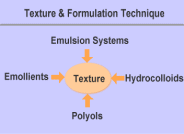 |

|
We can transform
your creative vision into a cosmetic product with any texture that you desire.
The value
of a cosmetic product is determined not only by how well it performs but also by
the sensory experience that it gives a consumer as it is being applied. Consumers subconsciously expect the claims
made about a product to match its texture. For example, if a product is for hydrating
the skin, consumers expect it to feel like water to the touch. If a product is
designed to lift the skin and improve its elasticity, how it feels while being
applied to the skin is one of the key factors that will determine consumers’
opinions on its performance.
What determines
the texture of cosmetic products?
Emulsions
are used in various ways in the cosmetics’ field, especially in skin-care
products. Cosmetic emulsions can be fluid emulsions or semisolid creams, and can
simultaneously deliver both lipids and moisture to the skin. Furthermore,
water-soluble and oil-soluble active materials, and even powders, can be combined
into the same product. Emulsions are a key form in cosmetics.
How are fluid emulsions and semisolid creams transformed when they are
applied to the skin? These products are smoothed onto the skin with the
fingers. During this process, oily materials
|
|
| gradually penetrate the stratum corneum, while some of the water and water-soluble
materials penetrate the stratum corneum and the rest evaporates. At the
end of this process, an emolient layer is left on the skin. The texture that consumers feel during this
transformation process may lead to the product being described as, for example,
“gentle and smooth” or “extravagant. |
 |
|
Ultimately,
the texture of the applied product depends on the type of emulsion system, and
on the emollients, hydrocolloids, and polyols that are used in its formulation.
|
|
| Emulsion Systems |
Hydrophilic–lipophilic balance (phase-inversion temperature) method, gel network system, polymer emulsification, D-phase emulsification, water-in-oil emulsions, etc. |
| Emollients |
Hydrocarbons, esters, vegetable oils, silicone oils, etc. |
| Hydrocolloids |
Various polymers are available, depending on the intended use (viscosity modifiers, gelling agents, film-formers, humectants, etc., of either natural or synthetic origin). |
| Polyols |
Butylene glycol, glycerin,dipropylene glycol, polyethylene glycol, saccharides, etc. |
|
How
should these choices be combined?
Marketing
surveys of new products often describe their formulations in unscientific
terms: “the skin penetration is good, but the feeling of the skin afterward is
not satisfactory,” or “very light and smooth on application, but too slippery
on the skin.” To meet the requirements of our clients, we scientifically
evaluate these expressions and translate them into chemistry. For example, the
first description may mean that the product includes too many ingredients that
have high skin penetration, while the description “too slippery” may mean that
the choice of hydrocolloids is inappropriate.
Unfortunately,
because cosmetics contain various ingredients that interact in complex ways, it
is not always possible to alter a product simply by changing the quantity of a
problematic ingredient.
We have a broad
range of knowledge of cosmetic ingredients, from the basic materials to
cutting-edge active ingredients, and many years of experience in creating cosmetic
formulations. We are also able to apply dermatological knowledge to the
development process, and can provide products immediately upon request with the
form and texture that you require.
We are constantly
searching the world for new cosmetic ingredients that can influence texture.
Furthermore, we also develop our own cosmetic ingredients to obtain innovative
textures.
Our laboratory contains instruments such as a rheometer that can evaluate the texture of emulsions, reducing development time. We also have developed technology that allows us to create better textures while preserving the stability of the product. Furthermore, with our on-site analytical equipment (the Halation Video Microscope and the DualCon™ system), we can quickly evaluate the stability of our emulsions, an important factor for cosmetic products in the market.
|
|
 |
|



